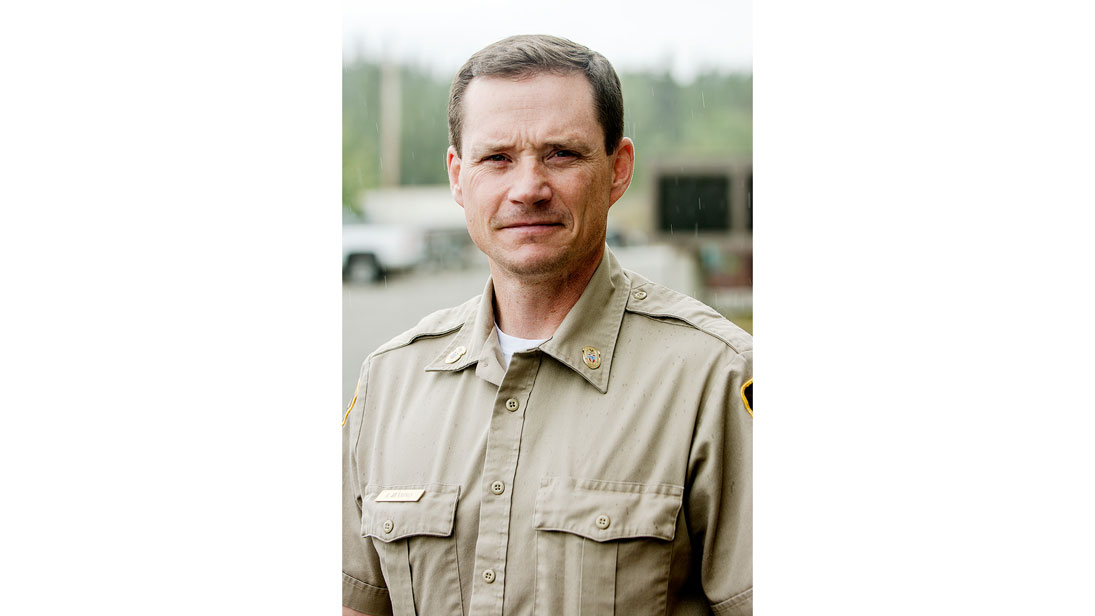
Photo by Whitehorse Star
BEING BEAR-AWARE – Leaving garbage in the back of a truck isnʼt secure, points out Ryan Hennings, Environment Yukonʼs manager of enforcement and compliance.

Photo by Whitehorse Star
BEING BEAR-AWARE – Leaving garbage in the back of a truck isnʼt secure, points out Ryan Hennings, Environment Yukonʼs manager of enforcement and compliance.
As leaves change colour and the thermometer dips, bears are stocking up on calories, preparing for hibernation.
As leaves change colour and the thermometer dips, bears are stocking up on calories, preparing for hibernation.
This is keeping conservation officers busy in the Whitehorse area.
On Friday, they were out near the North Klondike Highway and 10 Mile Road, just south of Lake Laberge, trying to locate a grizzly that had been shot by a resident.
Ryan Hennings, Environment Yukon’s manager of enforcement and compliance and the acting manager for the southern districts, said this morning the bear had been in the woman’s yard previously, attracted to her chickens.
She tried early Friday morning to scare it away with pots and pans, but it charged.
She shot it, and then it ran away.
Hennings said conservation officers found a blood trail about 100 metres long.
“We know it’s wounded,” he said. “But the significance of the injuries are undetermined at this point.”
The bear still hasn’t been located, despite conservation officers setting a trap.
Over in the Ibex Valley, near Scout Lake Road, a grizzly is becoming habituated to people.
Hennings said the bear is nocturnal, travelling among people’s homes, eating garbage, chicken feed and dog food, and causing property damage.
“It’s become a significant problem,” he said, adding that traps set in the area haven’t yet caught the bear.
He stressed that residents keep attractants secure at all times to prevent easy access to food – and leaving garbage in the back of a truck isn’t secure, he said.
“At this point, this bear is concentrating on non-native foods,” he said.
“It’s also reported as being a large bear, so it could be an old bear that has had a rough summer and is hungry and stressed and now taking these actions to try put on the weight, the fat and calories he needs to winter.”
In town, a black bear has been living on the escarpment for the past month, and has been spotted at the Pepsi Softball Centre, near the Yukon River in the industrial area, and near Robert Service Campground.
So far, this bear is consuming berries, Hennings said. When people see it, it runs back off into the trees.
“That’s a good bear. That’s what we want a bear to do.”
Still, people walking through greenbelt areas in the city should be aware of their surroundings, he said.
Fall is a critical time of year for bears as they prepare for hibernation, said Carmen Smith, WildWise Yukon’s program co-ordinator.
It’s the only season during which bears actually gain weight.
In a state called hyperphagia, they’re actively foraging and trying to consume between 15,000 and 20,000 calories a day.
That’s the equivalent of 55 chocolate McDonald’s milkshakes, Smith said.
A typical fall diet for bears includes berries and, depending on their location in the territory, salmon.
“A bear will eat up to 200,000 berries a day until the berries are lost when the frost becomes too heavy,” Smith said.
When that happens, bears will forage more widely, looking for roots and vegetation. This can also lead them to come into contact with people.
This year, there are fewer berries than usual, and they ripened later than usual, Hennings said.
“What we’re seeing now, I think, is the result of that, where bears are stressed and getting in conflict situations as they try to prepare for winter.”
Smith said it’s a particularly challenging time of year for sows, who mate earlier in the year but have delayed implantation.
This means that embryos don’t implant in a bear’s uterus until November or December.
“It’s completely related to how healthy they are and how much fat they have when they go to hibernate,” Smith said.
“If they don’t put on enough weight and they’re not in a good enough condition, then the embryos won’t implant and they won’t have cubs.”
Bears tend to begin hibernation when it snows and no other food is available.
Environment Yukon is reminding people across the territory to make best efforts to secure garbage and compost bins, as well as other attractants.
Hennings is also asking residents in the North Klondike Highway-10 Mile Road area to report any sightings of the wounded grizzly as soon as possible.
For more tips on how to manage attractants and stay safe in bear country, visit the Department of Environment’s website at www.env.gov.yk.ca/bearsafety.
To report an unusual bear sighting or incident, call the TIPP Line at 1-800-661-0525.
In order to encourage thoughtful and responsible discussion, website comments will not be visible until a moderator approves them. Please add comments judiciously and refrain from maligning any individual or institution. Read about our user comment and privacy policies.
Your name and email address are required before your comment is posted. Otherwise, your comment will not be posted.
Be the first to comment